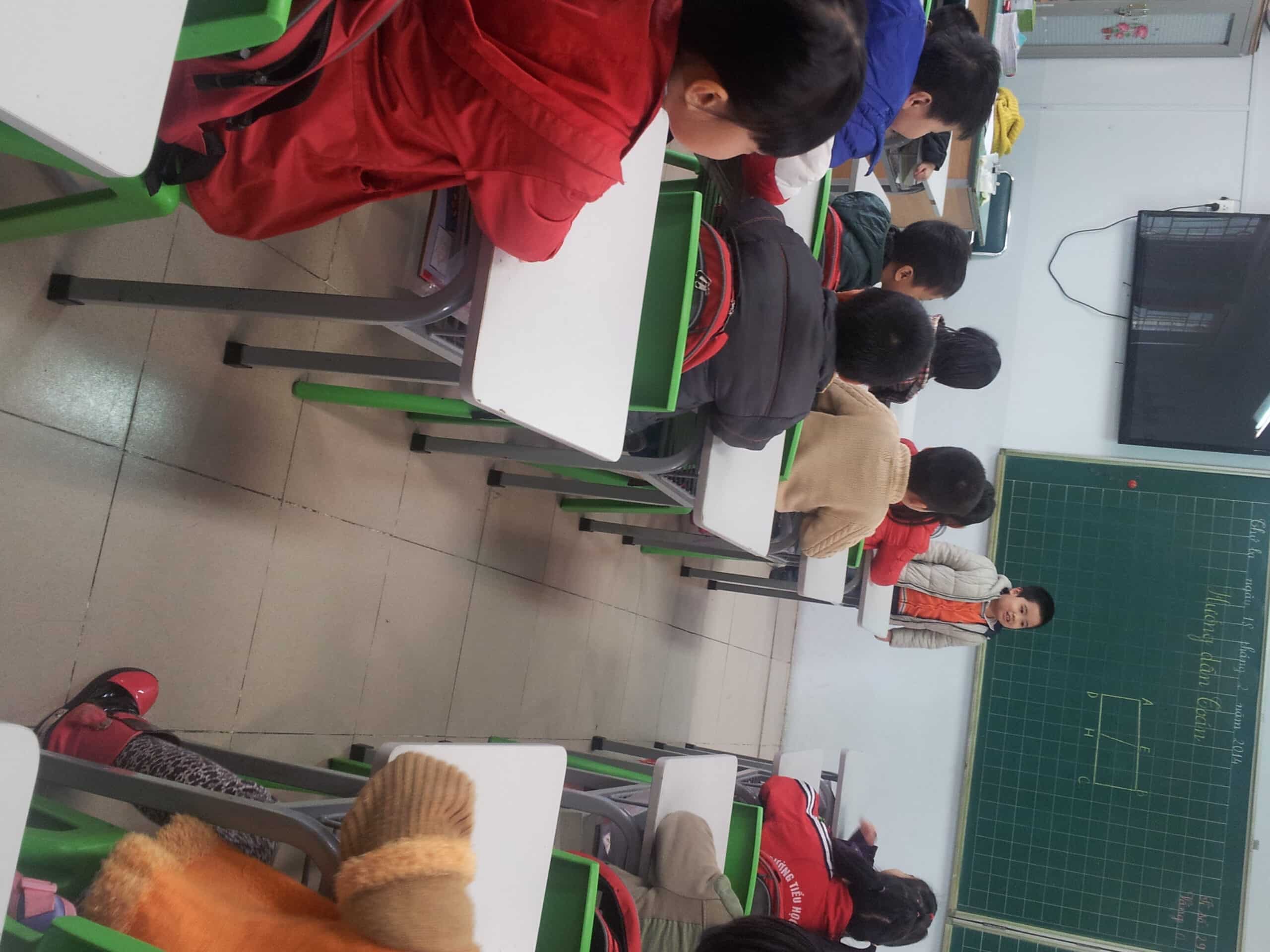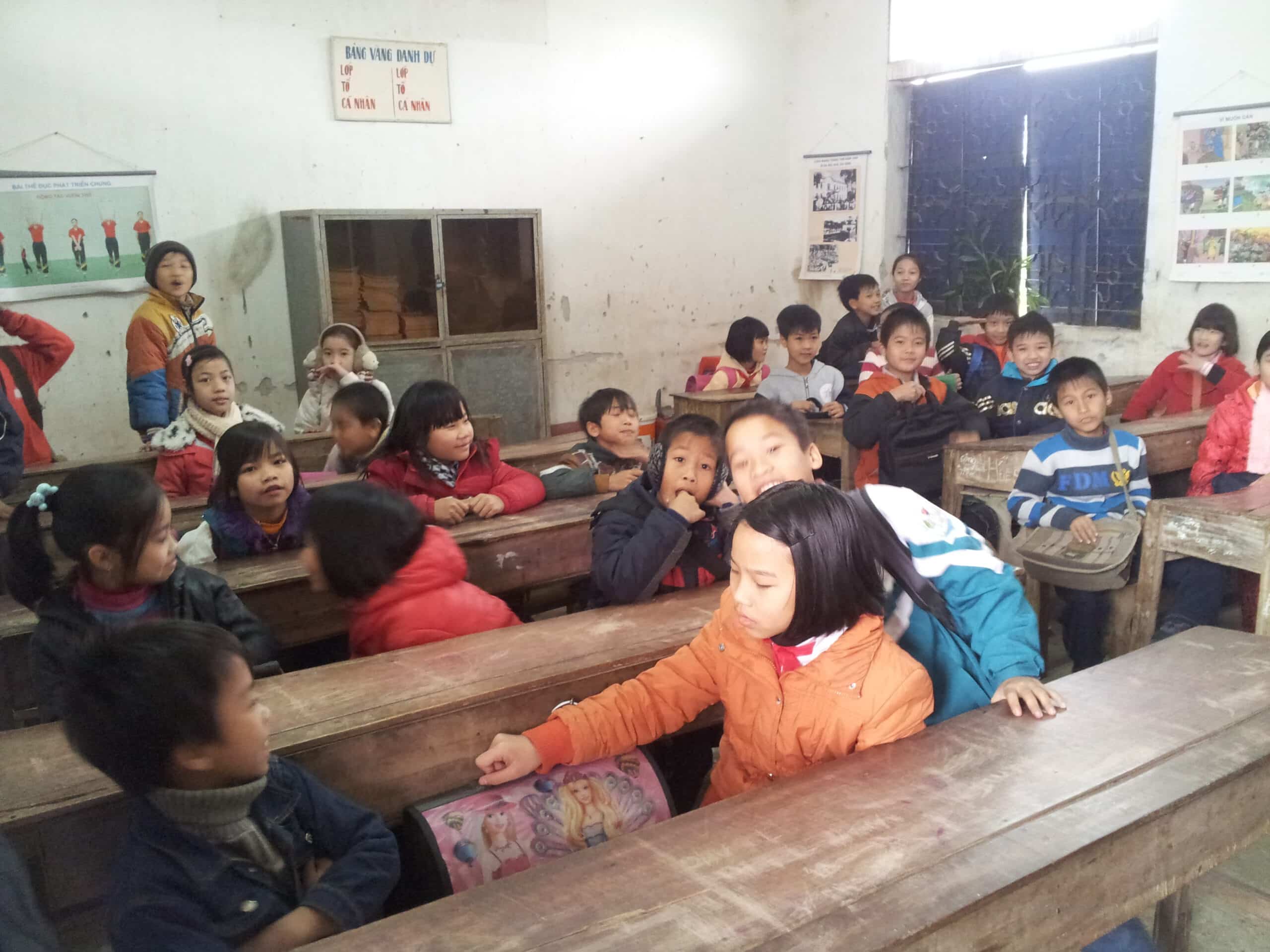The highlight of my first week in Vietnam was seeing the children in schools.
I had the privilege of visiting nine schools—five in Hanoi, three in the rural countryside, and one in a fishing village. There is nothing like hearing the unbridled laughter of children, seeing them learn in their classrooms, and speaking with dedicated educators who are working hard on the behalf of children.
To give a flavor of some of the schools, the first school I visited was Doan Thi Diem, a private school with two campuses serving roughly 3,000 students in primary through high school. A for-profit school—as are the vast majority of private schools in Vietnam I learned—it has been in operation for 20 years, which makes it one of the first private schools in the country. Students must apply and take a test to get in. The admissions’ process is competitive—last year 500 students got in out of the roughly 1,500 that applied. The school offers the national curriculum, was the first Vietnamese school to offer foreign language for Grade 1, the first in Hanoi to offer full-day schooling, and offers many extracurricular classes. It costs roughly $250 a month to attend, which includes tuition (roughly $150 a month), meals, and transportation. This cost is apparently on par with most private schools in Hanoi—a number that is increasing rapidly. It has 500 computers in the school, and its principal said that the whole staff is trained in information and communications technology (ICT). The school was notable for the sheer joy that emanated from its students throughout the campus and in the class that we saw.

At Olympia Schools, a nearby private school founded in 2003 that serves 444 students in primary through high school, the full cost to attend is higher at nearly $8,000 per year. But Olympia Schools compares itself to the international schools in the city, which are priced significantly higher. It was the first Vietnamese school with a college counselor on site like an international school—normally college counseling is offered via a separate paid center—and its graduates often attend university overseas. It stays open late to assist its parents who work. Olympia Schools offers some online learning options to its students—in particular through an online software program called English Central that assists its students in listening and speaking English. The school was very interested in expanding its use of online learning to create more personalized learning options for students and invited me back to speak to its staff a few days later about blended learning so that it could start a planning process immediately. I would not be surprised to see the school become a model for blended learning in Vietnam in the near future.

At the United National International School—one of two in the world—I saw a school that serves students from a diverse set of nations, including Vietnam, and takes the ethos of the United Nations as its guiding principles. The school serves 1,070 students from 3 year olds all the way through high school. The cost to attend varies depending on the grade—as the student-to-teacher ratio varies as well—but is on average roughly $20,000 per year. The school, which offers the International Baccalaureate (IB) diploma, also works to help the broader effort of improving education in Vietnam as well. Its head of school, Dr. Chip Barder, meets with policymakers, and the school opens its doors to educators in various public and private schools, many of whom are in some ways their competitors.
In my visit to the Vietnam-Australia School, I met with several teachers who serve Vietnamese students interested in studying abroad. The total cost to attend ranges from $3,000 to $6,000 a year. Founded seven years ago, the school is semi-international, which means that its dominant curriculum is the Vietnamese national one but that it also offers English alongside starting in Grade 1. The school is dedicated to offering its students the chance to study overseas, and it works hard to attract top English teachers and not settle for what its staff termed “backpacker” English teachers. The lack of good English teachers in the country is a significant challenge for public schools, the staff said.
I visited three schools in the Ha Nam province, a rural province to the south of Hanoi, including a primary school in the Binh Luc district, a kindergarten, and a secondary school. The primary school had 150 students, and the secondary school had 200—both relatively small. Both had little modern equipment. For example, the secondary school had two computers with Internet in the entire school—a laptop for the principal and a desktop that is shared by all the teachers. The primary school had one room for English that was outfitted with a computer and projector for English lessons, but little else. That room cost roughly $10,000 to build; the school principal estimated that a computer lab with Internet and 20 to 30 computers would cost roughly $30,000—a non-starter he said in a school that has not yet met the national standards for quality. Those standards are based on three factors: the quality of the facility, the human resources, and the academic quality, as measured by test scores (the end-of-semester tests are not created at the national or provincial level, but instead at the district level; the province has to sign off on the tests though, which allow for school comparisons). The school does not meet the national standards in terms of facility quality because the school is required to have such things as a music facility and a sports facility, which it cannot afford. This is outside of the school’s control, as it does not set its budget. Instead, the Ministry of Education and Training allocates central funds to the province, which in turn allocates funds to schools. Because provinces in Vietnam do not have enough revenue to support their basic operations, however, they often repurpose central budget dollars meant for education—even though this is theoretically illegal, according to Professor Nguyen Minh Thuyet, the former Vice Chairman of the Committee of Culture, Education, Youth and Children for the National Assembly. When I asked one of the school principals about the fact that he should have access to more funds, he shrugged his shoulders and just said that is the way things work. There are some hopeful signs in policy, as a new resolution adopted in December of 2013 would give school principals more autonomy over budget and to recruit teachers, but how the resolution will be implemented is still in doubt.

In the rural schools, I had the opportunity to talk with several students in their classrooms in English. They were shy—and understandably so—given that it is not every day that a Westerner visits them, but they were also spirited. I also saw the bureaucratic machine in motion in the way that teachers had to have their handwritten lesson plans approved a week before they taught them and show compliance that they taught the right lesson on the right day after the fact. One vice principal in one of the schools observed that many teachers simply go online to copy their lesson plans, so the former policy really is about compliance. Finally, the public schools throughout the country are not entirely free. They typically have fees that students must pay to attend. In the rural areas, this might amount to $100 per student per year, which is significant because farming families in these areas typically earn somewhere between $600 and $1,000 a year, I was told.
Across all the schools that I visited, I saw student-to-teacher ratios between 20 and 30 students to one teacher for the most part. Had I been able to visit a public school in Hanoi, my understanding is that the student-to-teacher ratios would have been closer to 50 to 1.
After a week of visiting schools and meeting with many policymakers and others involved in the education sector, I left with a few other thoughts worth sharing. First, one of the big challenges in Vietnam—as in education everywhere—is the gap between what people say they are doing and what they are actually doing, or what might be called “the implementation gap.”
Sometimes this manifests itself in the gap between words and policy on the one hand and implementation on the other hand. There are some wise policies being presented in Vietnam, and there are great thought leaders with great intentions, but the key for success will be in the implementation. There I have learned that the people on the ground have significant doubts. Corruption in the public schools—for example, bribes to get good grades, a practice that persists because of low teacher pay—also continues to hurt the chance of true education reform.
There has also been a communication challenge. When I told people that the Clayton Christensen Institute’s mission was to transform factory-model schools into student-centered ones, the reaction often was, “Oh yes, we have been doing that for a few years now.” But what they meant was that they had transferred away from strict teacher-delivered lectures to a slightly more student-centered lecture style that requires students to answer questions and respond to various prompts. Although directionally correct, it is still a very factory-based—or Cages for Ages, as I learned the Australians call it—system. The time that is spent learning is a constant, and each student’s learning is variable. I’m trying to shift my language here to saying “personalized” and “individualized” as a result, but I suspect those will have other connotations as well.
Competency-based learning also has a narrow definition here around strict knowledge and some skills, but not the wider range of competencies “that include application and creation of knowledge, along with the development of important skills and dispositions.” As a result, when I talked about the importance of competency-based learning, people said they were also moving toward adopting that, even though the national curriculum remains time based.
My takeaway is that using terms precisely and avoiding buzzwords is all the more important in this light, as is avoiding normative definitions that imply that just because something is being done, it is being done well. I can’t wait to keep learning in my travels in Vietnam.


